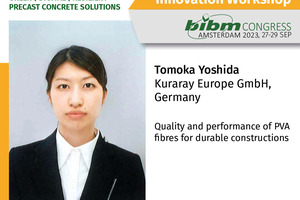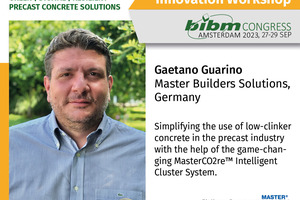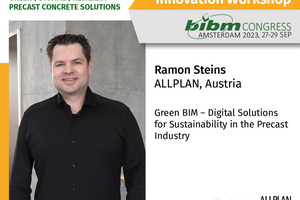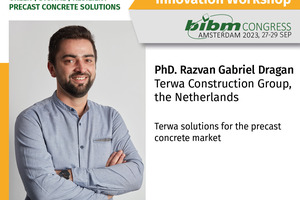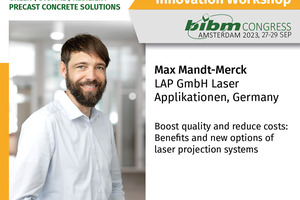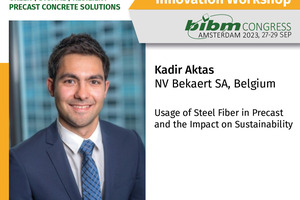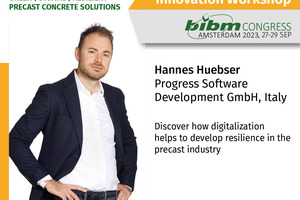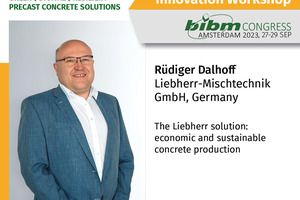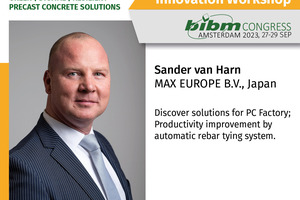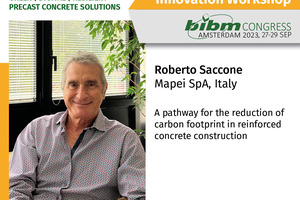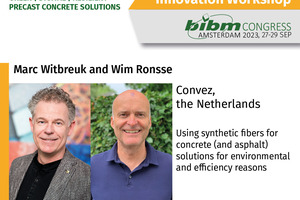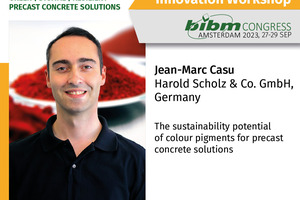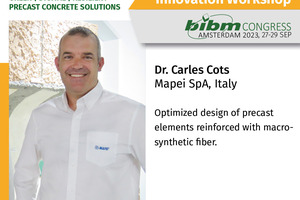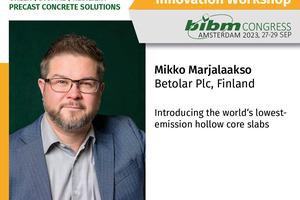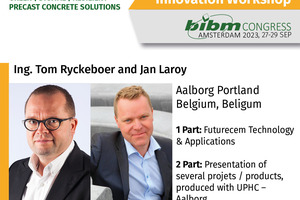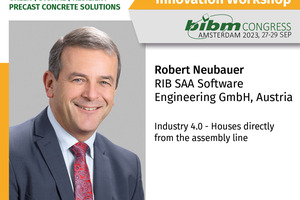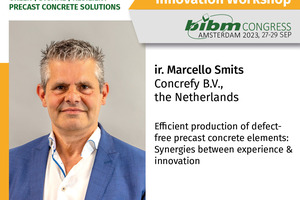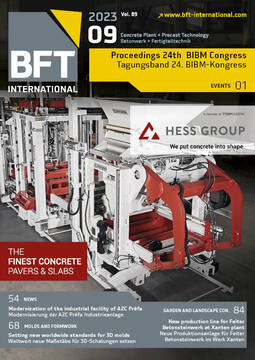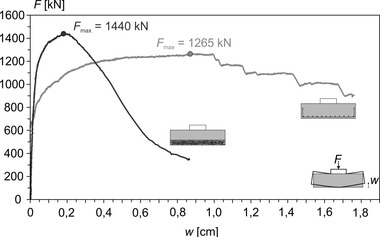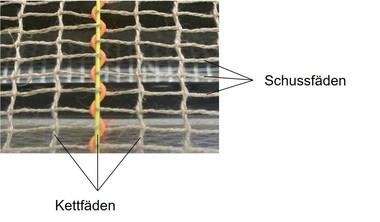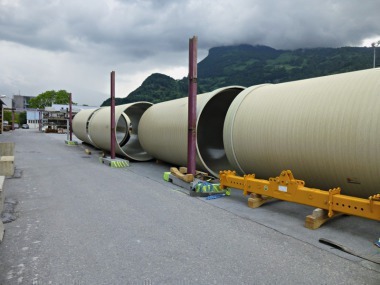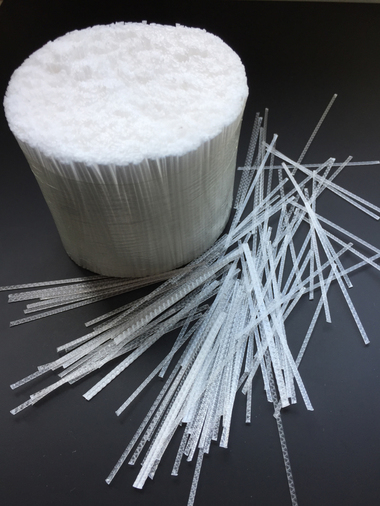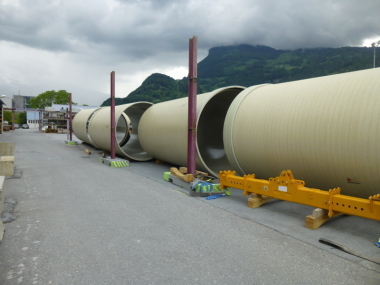Innovation Workshop
Quality and performance of PVA fibres for durable constructions (Tomoka Yoshida)
One of the trends in construction is the use of alternative materials to reduce the amount of concrete and cement used. As companies compete with each other, fiber reinforced concrete is attracting more and more attention as a solution in practice. Kuraray’s fiber solution is being selected as an incorporated material to enhance their environmental performance.
We will show you what the market is looking for and why, as well as introduce you updated Kuraray’s solutions.
Kuraray is a Japanese chemical company, founded in 1926 as a Rayon manufacturer, and now operates globally. Kuralon is a synthetic fiber which is made from Polyvinyl Alcohol (PVA) resin. In 1950, Kuraray started its commercial production of Kuralon, which was the first synthetic fiber invented in Japan and has already been in use in Europe for more than 40 years as a standard substitute for asbestos in Europe.
Referring to the concept of cement reinforcement in artificial slate, a fiber design suitable for concrete and mortar applications has been developed, and Kuralon offers some unique benefits in concrete & mortar reinforcing such as chemical bond with cementitious materials and alkali resistance and thanks to these features allows construction reinforced efficiently with:
outperforming steel fibers in lightweight, no corrosion
outperforming ARG fibers in higher alkaline resistance, higher elongation
outperforming PP fibers in higher tensile strength and modulus, better adhesion to cement matrix.
About Kuralon reinforced concrete and mortar in general: PVA fiber, Kuralon, bridges the crack mouth until initial phase of the fracture and keeps the crack mouth opening displacement narrow.
Main application to be focused:
General concrete & mortar mix especially for heavy-duty uses.
SHCC (Strain-Hardening Cementitious Composite) for repairment of road construction, 3D concrete printing technology, and others.
UHPFRC (Ultra-High Performance Fiber Reinforced Concrete) for iconic buildings.
Especially, Kuralon allows UHPFRC for decorative esthetics like fine-decorative and cladding façade, solar shading, and thin & light flat panels provide the following outstanding benefits to clients with:
Lightweight
High flowability
Larger panel per unit
Lower labor & fixing equipment cost thanks to no heavy subframe required
Long term durability.
Kuraray also showcases other construction applications stimulating end customer‘s insight for sustainable construction.
MasterCO2re: Intelligent Cluster System for Low-clinker Concrete Production (Gaetano Guarino)
Global concrete production accounts for 8% of man-made CO2 emissions worldwide. Although clinker, the main component of cement, accounts for only about 10% of the concrete volume, it is responsible for about 90% of the CO2 emissions in concrete. The ambitious CO2 reduction targets expressed in the European Green Deal of being climate-neutral by 2050 can only be achieved if the construction sector makes a significant step towards sustainable construction. The construction industry is already in a period of transformation. The introduction of the newly released cement standard (EN 197-5 2021) and the wide availability of cements with reduced clinker amount in the European market are the first signals of this process. Looking more closely at the precast segment, CEM I 52,5 R has almost disappeared in some European countries and its availability will continue to decline throughout Europe in the coming months or years. Alternative cement types such as CEM II/A-LL or CEM III/A offer significant improvements in reducing the embodied carbon of precast concrete elements but lead to various performance issues: loss of workability, deterioration of rheology, and reduction of mechanical properties. Lowering clinker content in concrete can be achieved not only by using clinker-reduced cement types but also by reducing a portion of conventional cements or by replacing a significant part of the cement with supplementary cementitious materials (SCMs). However, all these measures require a proportional reduction in water content to ensure both the water-to-cement ratio and the desired mechanical properties, especially in the early ages, which is often not possible due to the resulting deteriorated rheology.
MasterCO2re effectively counteracts these limitations and supports the achievement of challenging environmental targets by closing the performance gaps of low-clinker concretes compared to standard concrete mixes. It ensures superb workability retention, advanced rheology, excellent strength properties, and unmatched robustness even in concrete mixes with reduced clinker amount. MasterCO2re is a game-changing technology based on an intelligent cluster system (ICS) that delivers its effects precisely when required. A portion of its freely available polymers is immediately dispersed for initial water reduction. The finely tuned chemical structures of the diverse clusters optimize both workability retention and cement hydration by adapting the polymers‘ release mechanism to the cement matrix‘s characteristics. Both the required water-to-cement ratio and early and late strengths are reliably achieved, ultimately maintaining the durability of concrete structures. For concrete mixes where the amount of clinker is significantly reduced, MasterCO2re can be used in combination with Master X-Seed. The synergistic effect of the two admixtures allows a further boost to the early strength development required for fast demoulding of the elements to achieve the desired production output. The effectiveness of the new MasterCO2re technology is supported by a real-life use case that demonstrates the performance of MasterCO2re in practice using a low clinker concrete. In addition, the great potential in terms of CO2 and water savings is demonstrated by the new ECO2NOW app.
Green BIM – Digital Solutions for Sustainability in the Precast Industry (Ramon Steins)
Modern BIM software, such as Allplan, is critical to achieving global climate targets. Why? With BIM, automated production processes can be used to manufacture modular, prefabricated, or precast concrete components off-site. And, as research clearly shows, prefabrication significantly reduces the carbon footprint of construction activities. In addition, BIM enables the reuse of prefabricated elements.
There are countless ways in which digital solutions can have a positive impact on sustainability in the precast industry. In this article, we highlight four areas:
I. Developing a Sustainable
Building Life Cycle with BIM:
The concept of „data-centric life cycle management“ helps identify opportunities to make construction more sustainable at each stage of the BIM cycle. In the design phase, the guiding principles are life cycle assessment (LCA) design, building with renewable resources, reducing the use of materials, and LCA operation. In the construction phase, the key themes are modular construction, reducing waste and congestion, and a paperless site. In the operation and dismantling phase, building operators can consider monitoring energy consumption, structural health monitoring, and optimizing use efficiency. Finally, in the reuse phase, we look at building renovation, component reuse, and material recycling.
BIM software from Allplan helps to exploit the potential revealed by the building lifecycle.
II. Planning Suitable Buildings:
One example of how to increase efficiency in the planning phase is to use a large number of identical objects. Allplan allows designers to handle identical objects very efficiently. For example, to change the shape of 50 prefabricated columns, the change only needs to be made once. This even applies to similar objects such as mirrored versions. Allplan also offers the flexibility to design the most sustainable type of wall or slab for the project – from solid slabs, hollow core slabs, bubble slabs, girder slabs, brick slabs, brick slabs with infill, solid brick slabs – the possibilities are endless.
Allplan‘s interoperability features also allow designers to perform life cycle assessments. Allplan works with material databases as well as Power BI and LCA tools to calculate the CO2e emissions of a project. This way, different construction variants can be evaluated to find the most sustainable approach.
III. Building Sustainably:
Allplan software tools also cover the construction phase. They calculate the ideal sequence of production, loading, and assembly of precast elements. The use of a 4D approach and QR codes helps to avoid errors and, ultimately, construction delays.
When it comes to BIM-based retrofits, Scan2BIM technology is a big help: scanners can be used to reconstruct entire buildings from point clouds, making it easy to identify potential retrofits. The digitized building is also the perfect basis for planning modifications or extensions.
Allplan‘s interfaces to quality control tools such as Solibri are a great help when it comes to achieving excellence in construction. Avoiding design and execution errors also means avoiding wasted materials, energy, time, and, ultimately, money.
IV. Sustainability in Construc-
tion Research:
The Nemetschek Innovation Foundation, founded in 2020, works closely with the Technical University of Munich (TUM) to bring the benefits of artificial intelligence (AI) to the construction industry. So far, major milestones have been achieved in two areas: the AICC project uses AI to predict degradation and deterioration processes due to gas and moisture transport mechanisms. And DeepMonitor aims to provide a data-driven, robust, and computationally efficient system for detecting defects in building components. Both are key to extending the life of buildings while increasing safety.
Conclusion:
Digital solutions are the key to sustainability in the construction industry. This applies to the entire process, from the first sketch to planning efficient logistics and reusing precast elements. With the right tools, the potential for more sustainable approaches can be both identified and exploited.
Solutions for Precast Constructions (Razvan Gabriel Dragan)
Introduction
Terwa is a leading one-stop-shop company with extensive experience in producing metal components for the construction and precast industry.
With a focus on trends, innovation, and market expertise, we deploy the latest technology to deliver top-quality products certified for European standards and global norms.
Our commitment to customer service, combined with our deep product and manufacturing knowledge, ensures tailored solutions on projects that drive success for our clients.
Terwa incorporates sustainability as a core value in the company‘s mission statement, being dedicated to deliver sustainable construction and precast solutions that minimize environmental impact and promote long-term resource efficiency. It is essential for designers, manufacturers, and construction professionals to collaborate and adopt these sustainable principles to create more environmentally friendly and resilient structures.
Terwa Precast Connector – TPC:
Terwa Precast Connector “TPC” represents an innovative and strong connection system for precast concrete elements, such as walls and shafts, etc.
Advantage:
Quick and efficient connection of precast elements. The installation of precast elements does not depend on the weather.
Can be used in combination with a variety of our threaded fixing anchors TGK, TGL, HSP, fixing bolt anchor BBB, BBP and/or fixing inserts HBU, HBUS.
Simple connection solution without additional materials.
Lightweight.
Easy mounting in precast factories and on site.
Cost and time savings. The connections can be loaded to their maximum load capacities directly after installation.
Improved energy and efficiency - a shorter construction period reduces energy consumption at construction sites and CO2 emissions associated with the construction process.
Terwa Service portal
This platform, serves as a comprehensive and integrated interface that enables clients to access a wide range of specialized services, tools, and resources related to a varied range of elements and products.
Through the service portal, clients are granted a seamless and user-friendly online environment that optimizes their experience by offering personalized and self-service capabilities. The portal encompasses a comprehensive range of features, such as a secure login mechanism, a centralized knowledge base, technical support, calculation software solutions for lifting, fixing, sandwich and other system, BIM library and various other functions.
Terwa & NMB Splice Sleeve
Systems:
Grout-filled rebar splices connect structural concrete components used in building construction and civil engineering projects. This splice ensures the tensile strength equal to or greater than that of the rebar by filling and hardening grout in the sleeve where the rebars are inserted. The NMB Splice Sleeve Systems is the world‘s first grout-filled mechanical rebar splice developed to firmly connect precast concrete structural members.
Based on our extensive experience and accumulated knowledge of NMB Splice Sleeves Systems, the following three advantages are derived:
Improved seismic resistance: NMB Splice Sleeve Systems have the effect of reducing damage to buildings and structures caused by external forces such as earthquakes. By connecting rebars to achieve a performance equivalent to the rebar, the structural integrity is enhanced, resulting in improved seismic resistance. NMB enables the realization of safer buildings against natural disasters such as earthquakes, tsunamis, and floods.
Repair and reinforcement: NMB Splice Sleeves Systems allow for necessary repairs and reinforcement of buildings. For example, if a part of a reinforced concrete building is damaged, it can be cut out and repaired using our system. In the case of reinforcement, retrofit precast frames using our products braced to old buildings. NMB allows for the repair of aged or damaged buildings, making them habitable again without significant destruction. Reusing buildings reduces the production of new rebar and waste disposal, promotes efficient use of resources, and transforms them into more substantial buildings than initially built.
Improved energy efficiency: The combination of precast construction and the NMB Splice Sleeve system shorten the construction time and achieves high-strength buildings. A shorter construction period reduces energy consumption at construction sites and CO2 emissions associated with the construction process. Additionally, energy efficiency is improved through reusing rebars, reducing waste, and minimizing labor costs. Such efforts contribute to the advancement of the construction industry in a more sustainable direction, achieving high-quality buildings while reducing the environmental burden.
Boost quality and reduce costs: Benefits and new options of laser projection systems (Max Mandt-Merck)
Maintaining high product quality and minimizing production costs are paramount in today‘s precast concrete parts manufacturing landscape. Fortunately, technological advancements have paved the way for innovative solutions that address these challenges head-on. One solution involves laser projection systems for visual worker guidance, offering proven effectiveness in concrete precast production. Additionally, a camera system is now available, which can further enhance quality assurance.
The integration of laser projection systems has already demonstrated tangible benefits in precast concrete production. Notably, these systems accelerate production processes while avoiding errors and subsequent rejections. The decisive advantage over manual measuring methods is a continuous, software-supported digital workflow from CAD data to quality assurance and manufacturing documentation. This approach ensures a streamlined and error-free process from start to finish.
The advantages of laser projection systems extend to all workstations involved in precast concrete production. From the initial placement of formwork to the precise positioning of embedded parts, the display of cutouts, and rebar installation, digital work instructions provide clear guidance, enhancing efficiency and accuracy. In addition, laser projection systems help to check if all elements are included and their positioning and orientation are accurate before concrete pouring.
This is particularly critical in double wall production, as it ensures a perfect fit between the two walls and prevents any potential collisions between reinforcing bars or mounting parts during the joining process.
However, the potential for improvement continues beyond there. For companies with stringent documentation requirements, integrating camera and laser projection systems from LAP opens a new avenue for quality assurance in precast concrete production.
LAP’s DTEC-PRO camera system generates images that can be stored in organized folders or directly in a compatible database for documentation. The correct positions of all elements can thus be checked, and possible positioning errors can be detected even before the concrete is poured. Moreover, the system offers the ability to superimpose the laser projection outlines onto the images, providing a visual representation of the actual status of the work and allowing for easy comparisons with the projected contours. This innovative feature grants users digital proof that all work steps have been executed correctly, fostering confidence in the overall quality of the final product.
In conclusion, integrating digital laser projection and advanced camera systems presents a compelling proposition for precast concrete production. By harnessing these technologies, manufacturers can achieve higher quality and efficiency levels. The continuous evolution of such solutions empowers companies to remain competitive in the face of evolving market demands.
Usage of steel fiber in precast and impact on sustainability (Kadir Aktas)
Sustainable construction increasingly involves precast concrete in its design. Precasters around the world want to simultaneously solve their productivity challenges and answer the sustainability needs of their customers: buildings and structures should be built to last and use sustainable materials. Steel fiber reinforcement is an efficient and sustainable concrete reinforcement solution for both civil engineering precast applications (pipes, utility vaults and electric cabins) and building applications (modular housing, facade elements and sandwich panels).
Working with rebar and mesh involves the extremely time consuming and labor-intensive activity of placement, tying, cutting and bending of the reinforcement. In contrast, steel fibers are added directly to the concrete, guaranteeing a fast and safe solution on the construction site.
Further, steel fibers reinforce every part of the concrete structure, because unlike steel mesh, the fibers are distributed in every part of the concrete. This allows customers to reduce the amount of steel and in some cases the concrete thickness of precast elements, therefore resulting in savings in total cost of ownership with less material and labor needed.
These characteristics of steel fiber result in greenhouse gas emission hence reducing the carbon footprint. For utility vaults, when design is optimized to steel fiber reinforced concrete, we can reduce the wall thickness by 2cm and this lowers Global Warming Potential up to ~20% in the life cycle assessment. For concrete pipes which we can reinforce with fiber only, we can save up to 18% of CO2 emission. For wall panels, reducing the total amount of reinforcement material by half, results in up to 30% CO2 savings. The list goes on for many other precast elements from box culverts to segmental linings.
In conclusion, steel fiber can offer a solution to precasters to solve productivity challenges in labor scarcity, production output and has a net positive impact.
How digitalization helps to develop resilience in the precast industry (Hannes Huebser)
The precast concrete industry is undergoing a significant transformation, driven by advancements in digital technology. As construction projects become increasingly complex and demanding, the adoption of digital solutions is helping the precast industry to increase resilience and enhance its capabilities. This article explores how digitalization has the power to revolutionize the precast industry, enabling it to overcome challenges while staying competitive in today‘s rapidly evolving construction landscape.
Streamlining design and col-
laboration
Digitalization revolutionizes the way precast concrete elements are designed and produced. Computer-aided design (CAD) software and building information modeling (BIM) tools simplify and streamline the design process. These technologies allow architects, engineers, and precast manufacturers to collaborate seamlessly, reducing errors and improving efficiency. Precast models created with BIM enable stakeholders to visualize the final product, identify potential clashes, and make necessary design modifications before production begins, saving time and resources.
Enhanced manufacturing
efficiency
Digitalization revolutionizes precast manufacturing processes, resulting in increased efficiency and productivity. Automated production systems, guided by advanced software, optimize the production of precast elements, minimizing material waste and reducing manual labor. Robotic systems and 3D printing technologies are being integrated into precast production, enabling precise and consistent manufacturing while reducing dependency on human resources. This enhanced efficiency not only accelerates project timelines but also ensures consistent quality throughout the whole production process.
Improved supply chain man-
agement
Digitalization plays a vital role in improving supply chain management within the precast industry. From procurement to logistics and inventory management, digital solutions provide real-time visibility and control over the entire supply chain. With the help of sensors, internet of things (IoT) devices, and data analytics, manufacturers can track and monitor raw materials, the production progress and transportation, ensuring on-time delivery and minimizing disruptions. Predictive analytics can also help optimize inventory levels, reduce excess stock and minimize costs.
Enhanced project management
Digital tools are transforming project management in the precast industry. ERP management software, equipped with features such as scheduling, resource allocation, and progress tracking, ensures seamless coordination among project stakeholders. Real-time communication platforms facilitate instant information exchange, allowing for quick decision-making and problem-solving. Additionally, cloud-based storage systems enable easy access to project data, making information readily available to all team members regardless of their physical location. These digital solutions enhance project transparency, minimize delays, and improve overall project outcomes.
Changing the game
Digitalization has emerged as a game-changer for the precast industry, empowering it to tackle challenges head-on and develop resilience in an increasingly dynamic construction landscape. By streamlining design and collaboration, enhancing manufacturing efficiency, improving supply chain management, enabling efficient project management, and providing smart monitoring and maintenance, digital technologies are transforming the way precast concrete elements are produced, installed, and maintained. Embracing digitalization is no longer an option but a necessity for precast manufacturers looking to stay competitive, reduce costs, and deliver high-quality structures efficiently. That is why Progress Group, in addition to the mechanical engineering and precast concrete division, has been developing state-of-the art software solutions to offer a full-range service. Creating progress together with industry-proven BIM, ERP and MES solutions that unlock the full potential.
The Liebherr solution: Economic and sustainable concrete production (Rüdiger Dalhoff)
In recent years, the construction industry has been under increasing pressure to become more economical and environmentally sustainable. The production of concrete has come under scrutiny due to the high levels of carbon emissions associated with its production. In response to this, Liebherr has developed a range of innovative solutions that enable economical and sustainable concrete production according to the BIBM slogan “green, digital, resilient”.
As a full-service provider throughout the entire product life cycle, Liebherr offers a comprehensive range of products and services. This includes concrete mixing plants, truck mixers, concrete pumps, and moisture measurement sensors as well as spare parts, maintenance, and training. By offering a complete package, Liebherr can ensure that their customers receive the highest level of service and support throughout their project.
One of the key features of Liebherr‘s concrete production solutions is their wide range of innovative drives. These drives enable the ideal solution for CO2-optimized construction sites, depending on the application. For example, Liebherr‘s electric truck mixers are powered by a battery that significantly reduces CO2 emissions. Additionally, Liebherr‘s XPower driveline technology offers a unique combination of fuel efficiency and power, reducing the overall carbon footprint of the construction site.
Liebherr‘s commitment to sustainability extends beyond their product range. They are also focused on digitizing the construction industry to make it more efficient and eco-friendlier. Their digital solutions enable better planning, management, and monitoring of construction projects. This leads to less waste and more efficient use of resources.
For the concrete production Liebherr offers great solutions which fulfil the needs of reducing carbon emissions to become greener, which offer transparency in concrete quality data and machine health in order to become more digital and which provide web-based service solutions such as spare-part order shop for more resilience during the daily concrete production.
In detail, Liebherr developed a new batching plant platform which fits for customers within the ready-mix as well as in the precast industry and their individual challenges. Liebherr’s batching plant platform is one step ahead when it comes to cement savings due to its new and intelligent implementation of the frequency converter technology for all drives in addition to the intelligent Liebherr control of these drives. With a dosing accuracy of +- 0.5 %, up to 750 tons of cement can be saved per year (for an average concrete production of 100.000 m³). This equals yearly savings of approx. 75.000 € (100€/t cement) and of approx. 440 t of CO2 equivalent (0,587 t CO2 equivalent/ t cement in Germany). To store the amount of 440 t of CO2 equivalent, approx. 35.000 new trees must be planted.
Moreover, the well proven RIV series with mixer sizes in the range of 0.5 to 2.5 m³ offers great opportunities when it comes to mixing high performance concrete types. The successful implementation of these mixer types in various precast applications realized significant reduction of the mixing times up to 50%. With these improvements the production output as well as the efficiency could be increased significantly within several customer projects (e.g. with Max Bögl).
Liebherr always stays one step ahead when it comes to a greener future for our children. Therefore new developments across the digital linking of data of different systems, mobile APPs as assistant systems as well as predictive maintenance solutions are in the pipeline and will help to produce greener, more digital and more resilient concrete in the future.
In conclusion, Liebherr‘s economical and sustainable solutions for concrete production are helping to revolutionize the construction industry. As a full-service provider, they offer a comprehensive range of products and services, supported by a commitment to sustainability and digital innovation. With solutions that are tailored to the specific needs of each project, Liebherr is helping to build a more sustainable and efficient future for the construction industry.
Discover solutions for PC Factory; Productivity improvement by automatic rebar tying system (Sander van Harn)
Since 1942, Max has been recognized, worldwide, as a leading manufacturer of high-end industrial tools. Max product engineers concentrate on developing products with highly innovative and durable features to support the ever-evolving needs of the professionals that use them.
In our presentation, we would like to introduce how MAX automatic rebar tying system provides solutions which can meet some of the needs Precast Concrete Factory currently faces.
Brief summary:
The surrounding environment of the construction market is undergoing significant changes.
Particularly, there will be a further shift from on-site to off-site production in the future due to labor shortages, shorter construction times, standardization of quality and so on.
In order to continue sustainable growth in the future, addressing less labor force and improving the work environment will be major challenges.
Max automatic rebar tying system provides solutions for these issues to Precast Concrete Factory by our unique product features based on our 30 years experiences in this field.
In addition, as an innovative proposal in response to the changing environment, Max will introduce our future plan of rebar tying solutions, using IoT and robotics technologies.
Main Topics:
1. Introduction of Max & Rebar tying system
2. Solution proposal
For Productivity improvement
For Labor shortage
For Health & Safety / Working environment
3. MAX’s new approach to the innovative improvement response to changing environment.
Internet connected rebar tying system
Automated robotics rebar tying system
Max is looking for great partners to collaborate in developing the innovative system.
A pathway for the reduction of carbon footprint in reinforced concrete construction (Roberto Saccone)
The paper aims to increase the use low clinker cements, supplementary cementitious materials, recycled aggregate and synthetic structural fibers in the precast concrete industry in order to reduce the carbon footprint. The results from the paper show the possibility to design precast elements with new mix-design reaching the same technical requirements of concrete made of traditional materials.
Summary
In recent years, progress in reducing the environmental impact of the construction industry has been increasing dramatically on a global scale. As a country, Italy offers enormous opportunities for decarbonisation and the development of the circular economy. This is the context for the research project whose objectives and methods are presented in this paper: the execution of an industrial trial for the production and study of reinforced concrete beams with a low environmental impact. Within this research path there are many aspects of interest. The realisation of full-scale structural elements with ordinary construction details (e.g., concrete cover) allows the feasibility of the proposed solutions to be verified as early as the construction phase. The use of construction materials (i.e., Concrete and reinforcements) that comply with Italian regulations in regarding, for example, the use of SCMs, the use of recycled and artificial aggregates, and the use of structural plastic fibres and reinforcements allows for solutions that can have already now an enormous beneficial impact on the environment. To complete the research, an innovative concrete characterised by a reduced carbon footprint and the total replacement of natural aggregates (100%) with recycled and artificial aggregates was also developed with the help of tailor-made superplasticizers. The concretes involved in the experimental research are a traditional concrete (REF), which is a very common type of concrete for ordinary constructions, a standard green concrete (ECO1), complying with regulations in Italy, and an innovative green concrete (ECO2), which represents an advanced development of the ecological concrete concept, without the limitations imposed by Italian Structural Code regarding the use of recycled aggregates. The types of reinforcement used in Italy for the construction of structural elements are traditional steel bars (yield strength fy=450 MPa, ultimate tensile strength ft=540 MPa, elastic modulus Es=200 GPa). However, new types of reinforcement are now available; among these, it can be mentioned the GFRP bars (tensile strength ffu=760 MPa, elastic modulus Ef=46 GPa) and synthetic structural fibres (length 40 mm, aspect ratio 50, density 910 kg/m3). The possibility of reducing the carbon footprint of concrete produced in Italy is wide due to the low diffusion of type III, IV and V cements (with reduced Portland cement content) and due to the low diffusion of SCMs additions during concrete production. Although the current percentage of use of recycled or artificial aggregates in Italy is less than 1%, the development potential offered by the concrete sector is very significant: the target of 20% substitution of natural aggregate would lead to a saving of more than 10 million tonnes of natural aggregates and a simultaneous reduction of landfilling of about 7% of the total amount of special waste produced each year in Italy. A balanced design approach and the increased use of innovative concrete technologies (such as FRC or FRP bars) would optimise the use of traditional steel reinforcements and the geometry of reinforced concrete sections, leading to a more conscientious use of construction materials. The initial study of the concrete mixtures has shown how it is possible to develop high-performance mixtures with a reduced use of Portland cement and with a high use of recycled and artificial aggregates.
Think efficient and ecologic and use synthetic fibers for concrete (and asphalt) solutions (Marc Witbreuk, Wim Ronsse)
The presentation is about synthetic fibers and their use in both concrete and asphalt applications.
In general two types of fibers can be distinguished. Most fibers (the Crackstop types) only have the purpose of improving shrinkage behavior and abrasion resistance. A particular type, like the Ignis fiber, improves passive fire resistance. These are the micro fibers. On the other hand macro fibers (like Durus Easy Finish) result in more flexural strength and aim at replacing or reducing traditional (steel) reinforcement. In choosing the best synthetic fiber different characteristics of the fiber are relevant. Think of the CMOD-value, the diameter and the mixing behavior.
The different applications concrete and asphalt have their specific demands when using constructive fibers. For instance, the mixture is different (think of the absence of water in asphalt and the need for it in concrete). Consequently the preferred type of fiber used in concrete differs from the type of fiber used in asphalt.
When talking about concrete there may be a difference in application. Constructive fibers can be used in precast to replace or reduce steel reinforcement (bars or mesh), but they can also be used in flooring or infrastructure. In this case the aim can be a replacement of steel reinforcement, but another goal might be the reduction of the thickness of a layer and hence, the reduction of the amount of concrete to be used.
In asphalt in general no reinforcement is used. In that case the adding of fibers has the purpose to reduce the thickness of the layer or the extension of the economic lifetime of the asphalt construction.
Comparing with plain concrete, using synthetic constructive fibers increases the costs per m3 or ton. Therefore, using fibers should have advantages. And they do!
In the first place using fibers result in economic/financial advantages. In case traditional reinforcement is replaced or reduced because of the use of fibers, the material costs will drop, logistics costs will drop and handling costs as well. Less or no steel, less concrete (in certain cases), and less labor. In the Netherlands concrete companies face a lack of labor forces and therefore using fibers may be a solution. Besides, mixing fibers in concrete mortar is easier and quicker to realize than implementing steel reinforcement. And hence results in a financial advantage.
Another advantage of using fibers is the complete reinforcement of the element. Whereas steel reinforcement is fixed somewhere in the concrete, the fibers are dispersed completely in the concrete.
Further, using fibers has advantages from an environmental point of view as well. In the Netherlands as in other countries companies will more and more have to give insight in the environmental costs (carbon footprint, MKI) of their proposed solution, especially when they produce for administrative authorities. The environmental costs of a fiber-solution in concrete (and asphalt) in general results in a significant drop of the environmental costs.
The above mentioned advantages can be calculated. In the presentation some cases will be shown and it will be explained which advantages (finance, labor and environmental costs) have been realized by using fibers (instead of steel reinforcement) in these cases.
The sustainability potential of color pigments for precast concrete solutions (Jean-Marc Casu)
Optimized Design of Precast Elements Reinforced with Macro-Synthetic Fibers (Dr. Carles Cots)
Objective:
The objective is to present two practical cases of structural design, optimizing concrete precast with total or partial substitution by using mMSFRC. The procedure is identical for both cases: it starts with material characterization, followed by design to meet different limit states, and finally, the evaluation of technology advantages. The design considers the operational requirements as well as manufacturing constraints (demolding and lifting). The evaluation takes into account the current regulations and design guidelines, including specific criteria for synthetic fibers. Sustainability of solutions is emphasized alongside time and cost criteria in assessing alternatives.
Content:
Firstly, the advantages, limitations, and rationale of using synthetic fibers for structural purposes are discussed.
The optimal reinforcement range is defined extensively, comparing it with the minimum mechanical or geometric steel amount.
Post-fracture characterization methods based on different standards are then defined, along with additional tests related to energy absorption, impact resistance, durability, and sustained load response (temperature).
Qualitatively, the performance of common dosage ranges (3-9 kg/m³) and strength classes (C25-C40) is indicated, highlighting their flexural and shear response compared to conventional reinforcement. Using the aforementioned values, two medium-sized prefabricated elements are evaluated: a manhole/pipe and an industrial panel. Optimal design is proposed with total and partial substitution, respectively, and all possible limit states are evaluated. The response of Fiber Reinforced Concrete (FRC) is assessed for each load combination, ensuring compliance with manufacturing conditions (demolding) and final use conditions (SLS, ULS). The use of conventional concrete and VHPC/UHPC is considered as an alternative for the panel.
Different constitutive equation models (constant and multilinear) are used for the design of each case, considering different limit states. Additionally, introductory mentions are made of other advanced design methods (FEM) for other relevant aspects: embedded connector response, thermal loading and shrinkage analysis, etc. Two additional examples are presented where the described methodology can be applied, without going into detailed design: tunnel segments and electric cabinets.
For each element, alternatives are compared based on technical, economic, production, and sustainability criteria. The final point examines energy consumption, extension of service life, and techniques for recycling and reusing the fibers.
Introducing the world‘s lowest-emission hollow core slabs (Mikko Marjalaakso)
Low-carbon alternatives for
the construction industry:
Introducing the world‘s low#
est-emission hollow-core slabs
Cement production puts a heavy load on the planet due to the carbon emissions from the process. At the same time, industrial processes produce vast amounts of side streams that go to landfill. The use of cement in concrete production is one of the key areas to focus on when reducing the climate impact of the construction industry.
To reduce CO2 from the built environment, a lot of effort is done to increase buildings’ energy efficiency. More focus should be given to the materials used in construction, such as choosing innovative, circular materials.
The keys to climate solutions
are already in our hands today
Stricter carbon emission regulations require more sustainable solutions from the construction and concrete industry. As an answer to this, Betolar, a Finnish material technology company, has created a cement-free binder, Geoprime®. Geoprime solution is a proven solution for precast concrete products such as pavers, sewer pipes and roof tiles.
In addition, in June 2023, the world’s lowest-emission hollow-core slabs were announced by Betolar and Consolis, a European leader in precast concrete solutions. The companies conducted an extensive laboratory and industrial-scale testing program to research and develop Geoprime low-carbon hollow-core slabs. The test castings underwent comprehensive full-scale initial testing with various cross-sections, adhering to standard requirements.
The tests validated the production potential of manufacturing hollow-core slabs completely without cement – or to meet the standards – with a low 5% quantity of cement. With this solution, it is possible to produce hollow-core slabs that have up to 75 percent lower emissions than standard precast hollow-core slabs.
Concrete and construction product manufacturers can now start producing sustainable construction and concrete products by licencing the Geoprime solution, which currently uses locally available side streams such as fly ash and slag. At the current level, replacing cement with these side-stream materials would require four billion tons of side-stream materials annually, which is significantly more than their availability on the market. Therefore, Betolar is searching for the next circular economy binder material with its proprietary cloud-based AI platform. It has analysed and modelled data from over 250 different industrial side-streams to optimise concrete recipes for performance in strength and viscosity.
Join our presentation to hear more about our product innovations – and how you can get on board.

